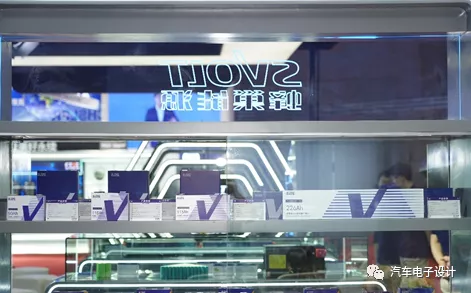Abstract
In the Chinese power battery industry, Honeycomb Energy, founded only three years ago, is very distinctive. Every year, various interesting battery demonstrations from Honeycomb can be heard, which are quite innovative. First, let’s talk about the big background of the industry. Currently, there are several characteristics in the overall industry pattern:
1) The head enterprises rely on large production capacity to lock customers, mainly because the cost of batteries is still lower than expected. Once the penetration rate of electrification in Europe and China exceeds a certain point, it may trigger further qualitative changes. This makes production capacity a very important consideration factor for automotive companies, especially for second-line enterprises that are currently in low production volumes.
2) Battery product differentiation is expected. Now, car companies require high energy density (to achieve 1000 kilometers), high rate fast charging capability (80% charged in 10 minutes), low cost (reduction of more than 5% per year in steps), high safety (passes thermal runaway experiment without catching fire), and the chemical system and comprehensive design of the battery must be played off between these characteristics.
For the battery product spectrum of second-line enterprises, they need to adapt to different sizes, different chemical systems, and different characteristics. Only by answering the above two factors can a company with potential for growth be formed. For Honeycomb, on the one hand, relying on the demand of Great Wall, it has started production; and in the current demand of GWh, it needs to plan for 200 GWh of production capacity in the future (24 GWh overseas). This requires strong innovative product technology support. What innovative products has Honeycomb brought to us at this Shanghai Auto Show?
Fast Charging Cells
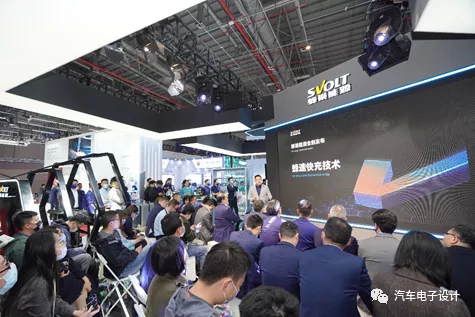
At this auto show, Honeycomb Energy brought new product technologies to everyone, including the development of high-rate fast charging battery technology and the landing of cobalt-free products. Compared horizontally, the pouch technology route has been recognized by the public and also opened the beginning of the auto industry’s entry into the field of cell manufacturing. In order for Honeycomb to go into mass production, it needs to find product technology support and gain customer recognition.
1) Development of Honeyfast Charging Cells
With Hyundai-Kia’s E-GMP, the 800V fast charging system will also enter the era of affordable price. As more and more companies invest in the construction of 800V systems and fast charging networks, fast charging batteries replace high energy density batteries and give users different choices: whether you want a short-range car that can be charged quickly or a high-mileage car with a large and expensive battery. In my opinion, with the installation of a large number of fast charging networks in the future, consumers will have several choices:
-
High-mileage vehicles: Because high-end customers are not sensitive to prices, they configure a range of more than 700 kilometers.- Medium-range vehicles: equipped with 70-80 kWh batteries that can last up to 500 kilometers, users can quickly recharge at high-rate charging stations and rapid charging networks.
-
Low-range vehicles: designed for economical use, users can choose based on their commuting range, but ultimately, they will prioritize fast charging capabilities as it can be inconvenient to frequently charge up with short driving ranges.
Therefore, fast-charging batteries are currently in high demand in the industry, and whoever masters this demand will have an advantage in providing fast and widespread coverage for mainstream vehicle products in the future. Of course, this demand is based on not having to make major changes to the existing battery design system. Hence, this time, FENGC’s new fast-charging technology and corresponding battery cell were first unveiled at this auto show, which can charge for 10 minutes and drive for 400 kilometers.
The first-generation FENGSU fast-charging cell is a 158Ah cell, with an energy density of 250Wh/kg, and 2.2C fast charging can achieve 20-80% SOC in 16 minutes. It will be mass-produced by the end of the year.
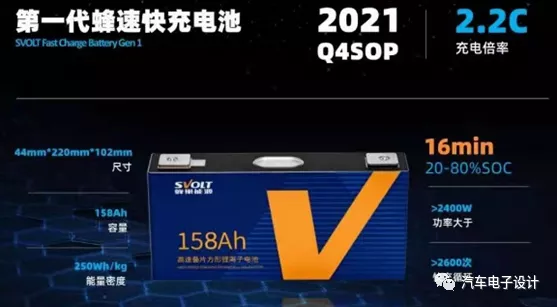
The second-generation 4C fast-charging cell has a capacity of 165Ah, an energy density greater than 260Wh/kg, and can achieve 20-80% SOC fast charging in 10 minutes. It is expected to be mass-produced in Q2 of 2023.
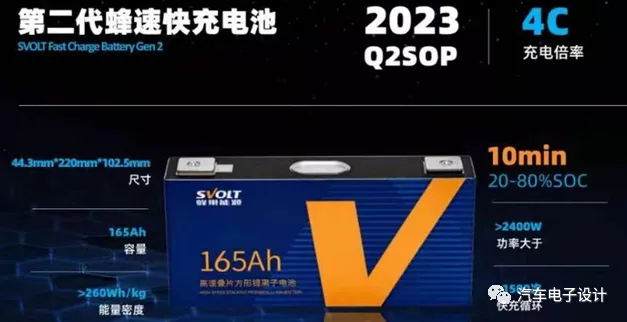
Based on the introduction, in order to achieve the goal of completing 80% of the fast charging in 10 minutes, technical optimization is necessary for the battery system. From the technical perspective, the main application technologies include:
On the positive electrode side, the precise control technology of forward precursor-directed growth is used, and by controlling the synthesis parameters of the forward precursor, the primary particle size is radiated in a radial pattern to create an “expressway” for ion migration, which improves ion conduction and reduces impedance by more than 10%. The multi-gradient three-dimensional doping technology has a synergistic effect on multiple elements for the bulk and surface doping, stabilizing the crystal lattice structure of high-nickel materials and reducing interface oxidation. Based on big data analysis and simulation calculations, a flexible coating material that adapts to significant volume changes in high-nickel materials is selected to inhibit cycle particle pulverization.
The negative electrode is an essential design, and several advanced technologies are used here as well:
-
Raw material type and selection technology: a combination of various homogeneous, different structured, and different types of raw materials are selected to reduce the OI value of the electrode sheet from 12 to 7, achieving an increase in kinetic performance;
-
Raw material crushing and shaping technology: using small bone particle size to form secondary particles and compounding them once to achieve rational particle size matching, which lowers side reactions and enhances cycling and storage performance by 5-10%.3. Surface modification technology: using liquid-phase coating technology to coat the surface of graphite with amorphous carbon, reducing impedance, improving the pathway of lithium ions, and reducing impedance by 20%;
-
Granulation technology: precise control of morphology and orientation between particle size, reducing the swelling of the full charge by 3-5%.
The electrolyte adopts a low-impedance additive system such as sulfur additive/lithium salt additive to reduce the film-forming impedance of the positive and negative electrode interfaces. The separator is a high-porosity ceramic film, which improves the ion conductivity of the separator while also considering heat resistance, achieving a balance between fast charging and safety. In the preparation of electrode sheets, a multi-layer coating process is adopted.
For the current overload capacity of the battery cell during fast charging, it needs to be confirmed by high-current simulation that the temperature of the structural components during the 600A high-current overload capacity fast charging process is less than 60℃. In order to ensure that the negative electrode does not undergo lithium plating, the three-electrode technology can be used to monitor the changes in the negative electrode potential in situ, simulate the charging voltage changes of the battery cell under different temperatures and currents, and extract the best charging Map.
The landing of cobalt-free products
Honeycomb Energy is currently the most eye-catching, mainly because of the landing of cobalt-free batteries. Previously, cobalt-free batteries were mainly divided into the E platform and the H platform, with a total of four planned products, which actually reflect certain differences.
My understanding of cobalt-free batteries is that on the resource-constrained end, like lithium iron phosphate batteries, they avoid relying on rare cobalt resources, and there is a lot of cost reduction space in long-term use. From the perspective of the industry, with Tesla using lithium iron phosphate products on a large scale in the Model 3, the use of lithium iron phosphate in China has increased significantly.
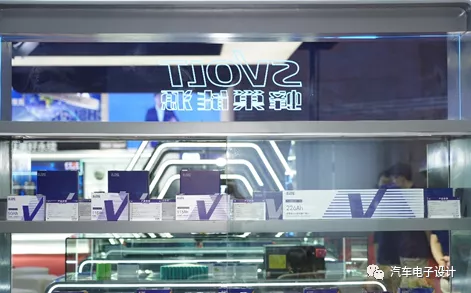
We can clearly see this from the production and installation volume of power batteries in 2021:
-
Production: In March, the production of ternary batteries was 5.8 GWh, accounting for 51.6% of the total production, a year-on-year increase of 79.6% and a month-on-month increase of 13.7%; the production of lithium iron phosphate batteries was 5.4 GWh, accounting for 48.3% of the total production. The cumulative production of ternary batteries from January to March was 17.8 GWh (54.3%);
-
Installation: The total installation in March of ternary batteries was 5.1 GWh, and the installation of lithium iron phosphate batteries was 3.9 GWh. The cumulative installation of ternary batteries from January to March was 13.8 GWh (59.5%), and the cumulative installation of lithium iron phosphate batteries was 9.4 GWh (40.4%).The difference between lithium iron phosphate and ternary batteries is narrowing, especially in the passenger car market where more and more models are adopting lithium iron phosphate batteries. Since breaking through the bottleneck of 190 Wh/kg in energy density, the changes in lithium iron phosphate batteries have mainly been in rapid penetration in passenger cars. In the current quarter, the proportion of passenger cars is compressed to 5-8% of the total, and with the increasing demand for lithium iron phosphate batteries in passenger cars, the overall proportion of lithium iron phosphate batteries is expected to surpass that of ternary batteries soon.
Honeycomb batteries also have plans for using lithium iron phosphate batteries. Currently, the company’s cobalt-free batteries are evolved from existing ternary batteries while keeping the energy density of the cells almost unchanged, creating a middle ground between ternary and lithium iron phosphate. These products include:
-
90 Ah VDA × 1.5 (39 x 148 x 102.5 mm) cobalt-free cells: mainly used for small cars, compatible with previous models and can provide 31 kWh of energy at 350 V.
-
115 Ah VDA × 2 (50 x 148 x 112 mm) cobalt-free cells: provide over 40 kWh of energy for slightly larger A0 level cars.
-
115 Ah MEB × 1.5 (33.4 x 220 x 102.5 mm) cobalt-free cells: support platform products for car companies, corresponding to mid-to high-end and high-end models.
-
226 Ah L6 (T21.5 x W118 x L574 mm) cobalt-free cells: the main component of CTP solutions.
These two platforms, E and H, have differences in material technology. E platform battery materials mainly use high-concentration cation doping and nano-network encapsulation, micro-particle size control, and lithium insertion path optimization. In 2021, the energy density reached 160 mAh/g and is expected to increase to 170 mAh/g in 2023. H platform battery materials mainly use nano-network encapsulation, single-crystal technology, and cation-doped oxygen octahedral structure. In 2020, the energy density reached 180 mAh/g and is expected to increase to 185 mAh/g by 2022.
In this sense, cobalt-free batteries have provided a path for the evolution of existing nickel-cobalt-manganese ternary batteries, and can maintain their price stability even under massive demand, while also providing enough progress space for energy density under the CTP technology of battery systems.
Conclusion
The proportion of passenger cars using lithium iron phosphate batteries is increasing, and honeycomb batteries also have plans for using them. Cobalt-free batteries have provided a path for evolution and can maintain price stability even under high demand, while also providing progress space for energy density under CTP technology.To achieve 200 GWh, we need to develop in multiple fields. Firstly, we will expand our domestic demand for power batteries. Secondly, we will focus on energy storage and other application areas, with emphasis on increasing shipment volume and enhancing our bargaining power in raw material procurement and supply chain control.
As a company known for its aggressive approach, CATL stands out in the battery industry in terms of innovation and product line expansion speed. Every year, we announce new products and technologies to the market and gradually fulfill our commitments to achieve the 200 GWh production capacity plan. Our annual activities and actual installation volumes demonstrate real progress, and we need to understand this company gradually through its products.
This article is a translation by ChatGPT of a Chinese report from 42HOW. If you have any questions about it, please email bd@42how.com.
